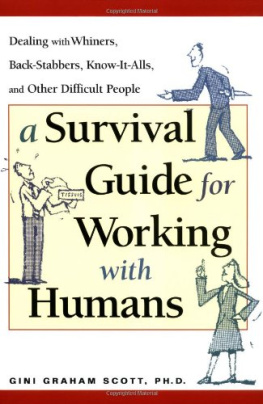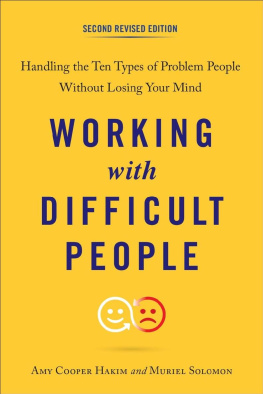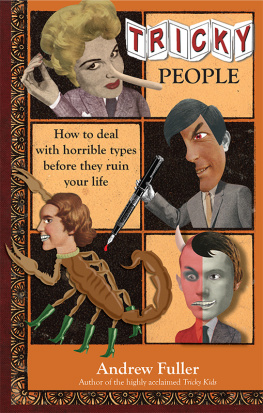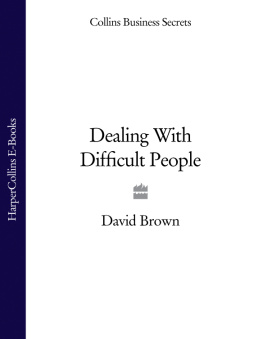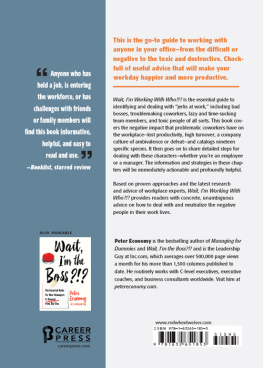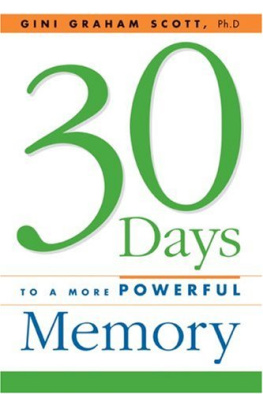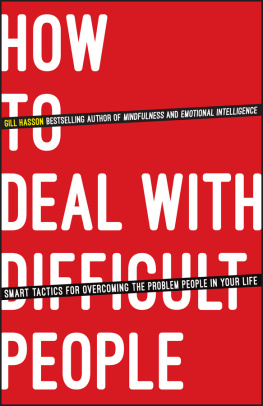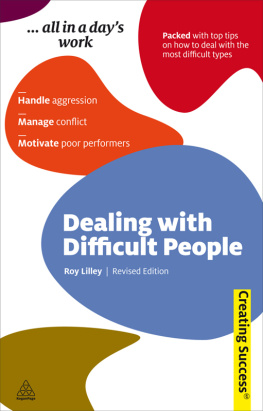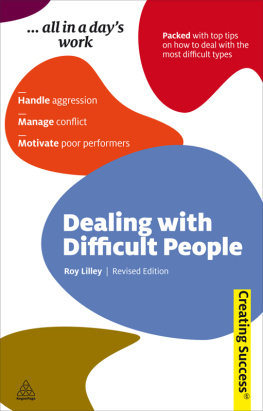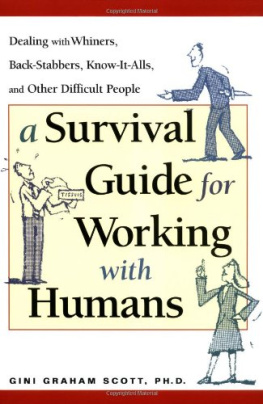A Survival Guide for Working with Humans
Gini Graham Scott PH.D.
Dealing with Whiners, Back-Stabbers, Know-It-Alls, and Other Difficult People
AMACOM
AMERICAM MANAGEMENT ASSOCIATION
Special discounts on bulk quantities of AMACOM books are available to corporations, professional associations, and other organizations. For details, contact Special Sales Department, AMACOM, a division of American Management Association, 1601 Broadway, New York, NY 10019.
Tel.: 212-903-8316. Fax: 212-903-8083.
Web site: http://www.amacombooks.org
This publication is designed to provide accurate and authoritative information in regard to the subject matter covered. It is sold with the understanding that the publisher is not engaged in rendering legal, accounting, or other professional service. If legal advice or other expert assistance is required, the services of a competent professional person should be sought.
Library of Congress Cataloging-in-Publication Data
Scott, Gini Graham.
A survival guide for working with humans : dealing with whiners, back-stabbers, know-it-alls, and other difficult people / Gini Graham Scott.
p. cm.
Includes bibliographical references and index.
0-8144-7205-2
1. Conflict management. 2. Interpersonal relations. 3. Interpersonal
conflict. I. Title.
HD42.S358 2004
650.13dc22 2003020908
Copyright 2004 Gini Graham Scott, Ph.D.
All rights reserved.
This publication may not be reproduced, stored in a retrieval system, or transmitted in whole or in part, in any form or by any means, electronic, mechanical, photocopying, recording, or otherwise, without the prior written permission of AMACOM, a division of American Management Association, 1601 Broadway, New York, NY 10019.
10 9 8 7 6 5 4 3 2 1
Acknowledgments
I want to extend my thanks to the many people who contributed to this book, especially to:
My editor at AMACOM, Jacquie Flynn, who helped guide the process of turning what began as newspaper columns in a dozen papers into a book. She offered many insights and was always cheerful and fun to work with.
My copyeditor, Barbara Chernow, who made the review process a breeze.
The agent I worked with on this book, Mike Valentino, at Cambridge Literary, who handled the follow-up and contract details, after I sent out an initial query through publishersandagents.net.
And to the many people, who must remain unnamed, who described their own workplace problems and conflicts and asked for advice.
Gini Graham Scott
About the Author
Gini Graham Scott, Ph.D., J.D., is a specialist in organizational behavior, interpersonal relations, group dynamics, conflict resolution, creativity, problem solving, and decision making. Other specialties include criminal justice, law, popular culture, and social trends. She is a speaker, workshop/seminar leader, and organizational consultant to business, government, and not-for-profit organizations and has spoken to top executives, managers, professionals, and the general public. Besides writing for magazines and for private clients, she has published more than 35 books, written dozens of articles, and has scripted a dozen screenplays, one expected to begin production in 2004.
She syndicated a column on relationships in work and business for about a year in about a dozen papers, which turned into A Survival Guide to Working with Humans. Her other books include: Work with Me! Resolving Everyday Conlfict in Your Organization, The Empowered Mind: How to Harness the Creative Force Within You, Mind Power: Picture Your Way to Success in Business, The Truth About Lying, and Making Ethical Choices, Resolving Ethical Dilemmas.
She has been a featured guest on hundreds of television and radio programs, including Oprah, Montel Williams, the O'Reilly Factor, CNN's "Talk Back Live." She has been teaching occasional classes on business, law, organizational behavior, marketing, management, psychological profiling, and privacy, including some for the University of Notre Dame de Namur in Belmont, California, and the Investigative Careers Program for private investigators in San Francisco.
For more information about books, workshops, and speaking, you can visit .
Introduction
Today, with a sputtering economy, collapsing and merging companies, corporate scandals, high-tech upheavals, and growing global competition, life in the workplace is more difficult than ever. Trusting in business relationships has become more uncertain, too.
It helps to have guidelines on how to maneuver through today's unpredictable work environment, much like learning to swim through a narrow chasm in a swirling river.
That's what A Survival Guide for Working with Humans is all about. It started with a series of mostly weekly columns in the San Francisco Bay Area on the perils of the workplace and what to do about them. Eventually my editor had to drop the columns to run more advertising and specialty features, but as reader response grew I decided to expand on the idea for these columns and turn them into a book. In a sense, I decided to take my own advice: to find a way to turn a problem into an opportunity and look for ways to put a positive spin on whatever happens. Indeed the columns themselves were inspired after a long-term relationship with a difficult client went south, and my solution to the problem ended up as the topic of one of the first columns.
Then, as I heard from readers, I saw how my own approach helped others. It's based on using a method I developed through consulting, doing workshops and seminars, and writing books on a wide range of topicsfrom becoming more creative to making choices, solving problems, dealing with change, and resolving conflicts and ethical dilemmas. This approach reflects a mix of using problem solving and conflict resolution techniques, along with employing methods such as visualization, mental gymnastics, and intuitive reasoning to decide the best approach. It also features an emphasis on using common sense and playing fairbut at the same time accepts the need to be aggressive and even devious when confronting a stacked deck. Other basic principles include seeking clear communications, promoting increased productivity along with improved morale and relationships, and contributing to the common good while helping yourself. In short, this approach is a combination pragmatic/ethical, intuitive/rational, follow-the-rules but know-when-to-make-or-break-them method that makes work and business, as well as personal relationships, more successful.
What's important in using these methods is to recognize that no one size fits all, and different principles, strategies, and tactics will work best for you at different times. But as you think about how other people have applied these techniques and principles, you'll start thinking how you might use them yourself in different situations, with different people, and for different purposes.
So consider these chapters as a series of recipes for coming up with a better way of dealing with your everyday experiences at work and in business relationships. It's the first in a series of books of recipes for success, which cover questions on everything from how to remake yourself in a more diversified workplace to how to deal with backstabbing, gossip, poor communication, and even when to bring in the lawyers or go to court.
In keeping with this recipe approach, each chapter includes:
An introductory paragraph highlighting the problem.
A short story or a couple of stories about one or more people who faced this problem (with their identities and companies concealed, of course).
A quiz with a list of possible responses so you can think about what you might do; you can even use this as a game to discuss this issue with others and compare your responses.

